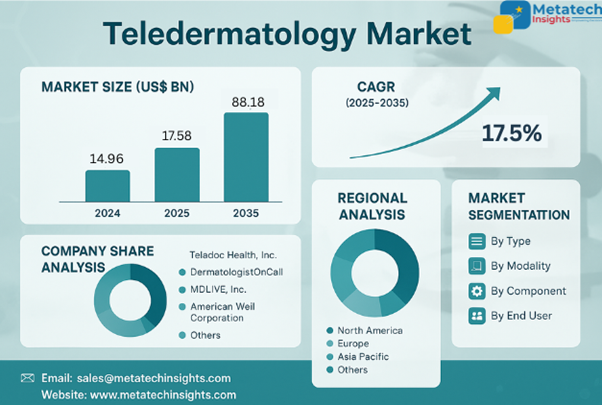Global Teledermatology Market to Hit USD 88.18 Bn by 2035 | CAGR 17.5%
09 Aug 2025 | Report ID: MI3323 | Industry: Healthcare | Pages: 220 | Forecast Year: 2025-2035

Read more about this report- Global Teledermatology Market to Hit USD 88.18 Bn by 2035 | CAGR 17.5%
The Teledermatology Market is valued at USD 14.96 billion in 2024.
The Teledermatology Market will achieve USD 88.18 billion by 2035 through a projected 17.5% CAGR from 2025 to 2035.
The Teledermatology Market is witnessing a surge in growth due to increasing demand for remote skin care facilities, increasing incidence of skin diseases, and growing demand for affordable and convenient dermatological consultation. The increase in digitalization of healthcare on a global scale, along with the development of high-level imaging capabilities, mobile health apps, and AI-powered diagnostic tools, has allowed dermatology services to be much more accessible, faster, and tailored to the needs of the individual client. The rise in awareness regarding the early diagnosis of skin cancers, skin acne treatment, and monitoring of skin conditions is also driving adoption.
The market can be classified into store-and-forward teledermatology and real-time teledermatology by type. One method that is still quite popular is that of store-and-forward because it best suits the process of primary care or rural outreach by transferring good image quality in an asynchronous manner. Real-time teledermatology is becoming increasingly popular in big cities and professional healthcare establishments because of the necessity of immediate consultation and interaction in diagnosis.
Based on modality, the web-based platforms, cloud-based solutions, and mobile applications are utilized to provide teledermatology services. The usage of cloud-based systems is gaining popularity as they have the ability to scale, be remotely accessible, and have the capability to manage data. In the area of moderate digital infrastructure, web-based platforms continue to prevail, whereas mobile applications are also experiencing active growth due to smartphone penetration and technologies of skin analysis through AI.
The component segmentation of the market is services, software, and hardware. Virtual dermatology consultations and chronic skin disease management are the most significant parts of the services, along with follow-up care. The sphere of software is advancing at a brisk pace with such solutions as lesion discovery components with the help of AI, EHR, and patient engagement tools. Digital dermatoscopes and high-resolution imaging devices are examples of hardware that facilitate the increase in the accuracy of the diagnosis.
The market constitutes, by end-user, the hospitals & clinics, specialty dermatology centers, home care settings, and others. Integration of teledermatology in the diagnosis and establishment of time to make plans to treat the patient is the key to taking over the market by hospitals and clinics. On one hand, the dermatology specialized centres are expanding their teleconsultation services; on the other hand, there is an increase in the level of home care associated with patients who want the convenience of a follow-up visit and monitoring of the process of the skin condition.
The teledermatology market is supplemented by favourable regulatory policies, the growth in digital health infrastructure, and bolstered post-pandemic normalization of virtual dermatology appointments. Remote dermatology is becoming more available with such efforts as local government initiatives, insurance reimbursement, and mobile imaging progress.
The geographical extent of the market is North America, Europe, Asia Pacific, Latin America, the Middle East, and Africa. North America is in the lead with a high adoption of telehealth, incentives for reimbursement, and a developed digital ecosystem. The most promising region is Asia Pacific, which could be attributed to mobile health incorporation, the rising level of dermatology awareness, and healthcare delivery in rural areas.
The major market competitors in the teledermatology market are Teladoc Health, Inc., DermatologistOnCall, MDLIVE, Inc., and American Well Corporation, among others. To provide high-quality, efficient, and patient-centered virtual dermatology services, these companies are concentrating on strategic partnerships, integration of AI, diversification of services, and expansion of the platform.
Maximize your value and knowledge with our 5 Reports-in-1 Bundle - over 40% off!
Our analysts are ready to help you immediately.
